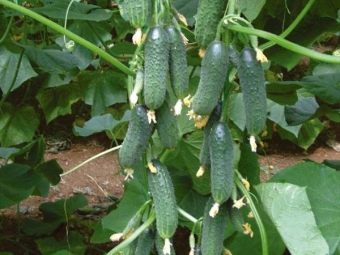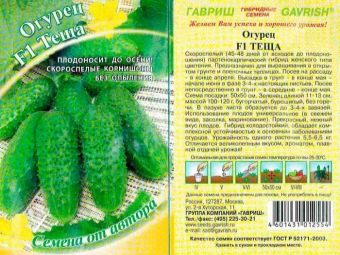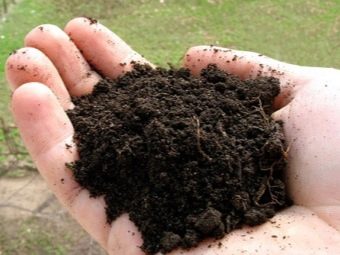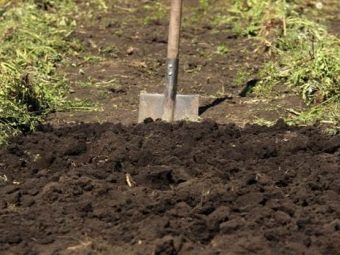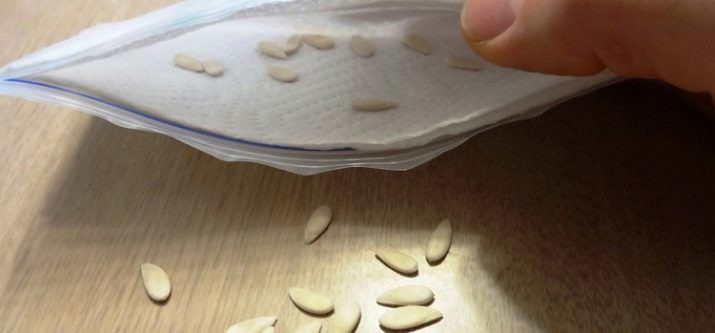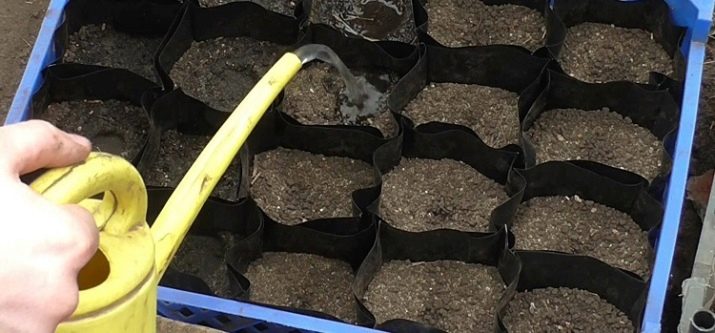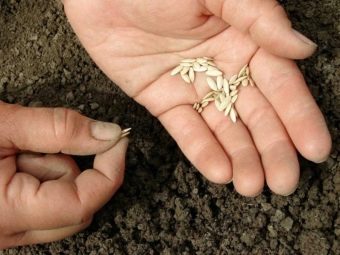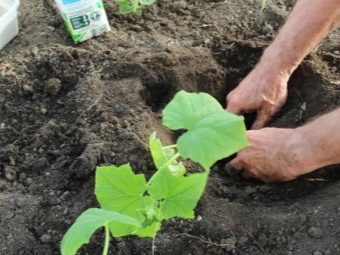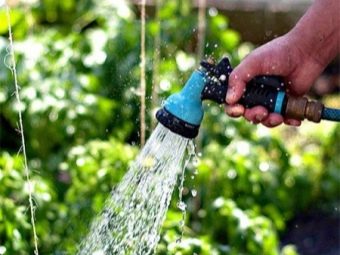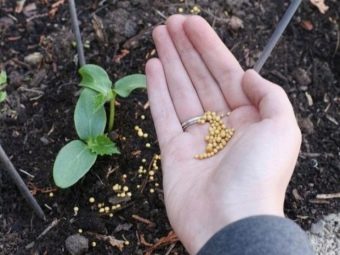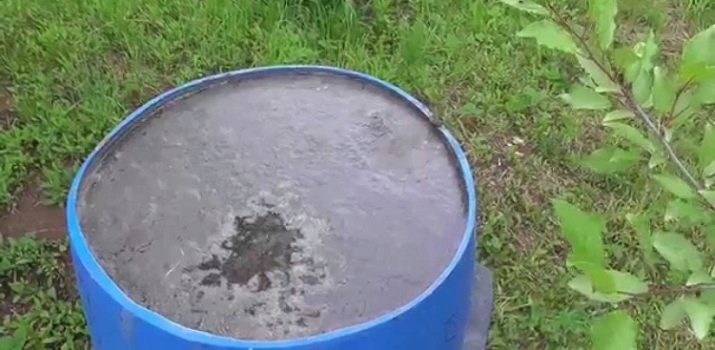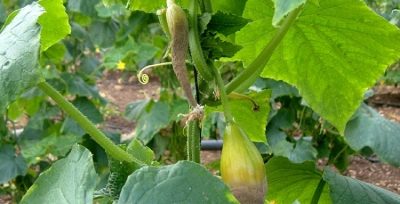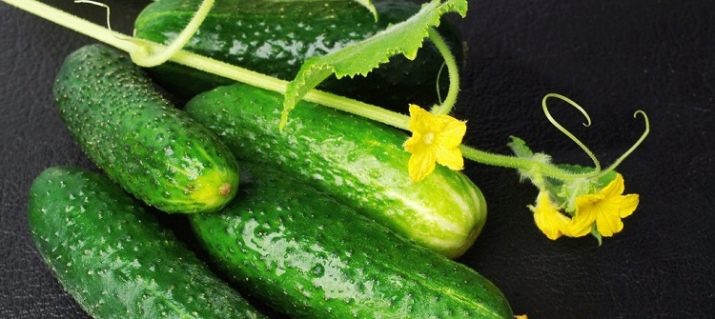How to grow cucumbers variety "Mother-in-law F1"?

It is impossible to imagine a holiday table or a picnic without such a universal product as cucumber. Fresh vegetable salad, okroshka, pickled cucumbers - no one can resist such simple but incredibly tasty dishes.In order for cucumbers to suit the taste of all households, as well as not cause any problems during cultivation, experts recommend choosing the mother-in-law variety "Mother-in-law".
Characteristic variety
Variety refers to the early ripening, usually harvesting is possible already in 45-50 days after the first shoots. The bush is a vigorous, medium-leaved, with 2-4 ovaries. Fruits usually have a length of 11-15 cm and a diameter of 3-4 cm. They are slightly prickly, spines and tubercles can be observed. The mass of one fruit is 100-125 grams. The rind is soft, dark green.
The flesh is crispy, characterized by density, lack of voids. Cucumbers have a good taste, fresh aroma, no bitterness is felt in them. They can be consumed fresh. They are also perfect for salting and pickling (gardeners especially recommend using female fruits in this case). Another advantage of the variety is frost resistance. It is worth noting the high yield - 10-12 kg per 1 m2.
Site preparation
Important when planting seedlings or seeds of this variety in open ground is the preparation of the site. When choosing a place follow the following rules:
- it should be a ridge well illuminated by the sun, but protected from the wind;
- corn, sunflower, dill can become an effective shelter from wind gusts;
- it is desirable to change plots for planting cucumbers every year;
- 200 g of ash and a bucket of humus are required for every 1 m2, you also need to dig up the ground;
- if manure forms the basis for feeding, then it is better to add it 40 days before planting or in the fall (bucket per 1 m2);
- normal store mixes will also be suitable as fertilizers: nitroammofoska, “Gumi-Omi cucumber-zucchini-melon”.
It is important to pay attention to the neighbors and predecessors of cucumbers. Tomatoes, cabbage, corn, potatoes, and root vegetables can be chosen as precursors. Culture grows very well next to dill, marigold, radish, beans, garlic. If tall plants are planted side by side to protect from the wind, then they should not block the sun. It is better to land them on the north side.
The landing time is approximately the beginning of May. Soil temperature at a depth of 8 cm should not be below 8 degrees Celsius.
Seed preparation
An important stage of planting is the preparation of seeds. There are three processing methods.
- Leave the planting material near the heater at a temperature of 25 degrees, then disinfect the seeds in a mixture of 30 g of garlic mash and 100 liters of water, leaving them there for an hour.
- You can wrap the seeds in wet gauze and soak in a warm place for 2-3 days. The recommended temperature is no higher than 30 degrees.
- The third way is the easiest. You can pre-buy the processed planting material. For example, it is possible to distinguish the already prepared seeds “Mother-in-law F1” of the company “Gavrish” by color. If they are painted, then they no longer need to be processed.
Seedling
The variety can be grown as seeds, planted directly in open ground, and seedling method. If the second option is chosen, then it is worth following the following algorithm of actions:
- Prepare containers with a height of 10–12 cm for each grain (the fact is that the vegetable does not tolerate injury to the root system);
- place in the pot drainage and food (usually gardeners recommend mixing sawdust, humus and peat in proportions 1: 2: 2 respectively, then mix 10 kg of the mixture with 30 g of nitrophoska, 40 g of ash);
- dig holes in each pot with a depth of 2 cm;
- put a seed in each, sprinkle with earth and pour;
- cover the container with glass.
The first shoots should "slip" after about 30 days. That is, planting seeds for seedlings should be already in late March - early April. Transplantation in open ground or in the greenhouse is carried out when the shoots have 3-4 leaves.
There are several basic rules for transplanting.
- Pre-shoots should be poured abundantly with warm water.
- Planting cucumbers in the ground is better on a rainy day.
- Between the holes for landing should be a distance of 25-30 cm.
- You must ensure that the plant stood upright.
- If planting is made under the film, then it should not touch the shoots.
- Young sprouts need daily watering.
- When growing in a greenhouse, it is necessary to avoid sudden changes in temperature from greenhouse to street.
- If there is low humidity in a greenhouse, a container with water placed in the center can increase it.
If the method of planting is chosen directly in open ground, then it is possible to organize cultivation in the greenhouse or in the fresh air. Also, many gardeners recommend planting cucumbers of this variety under the film. The landing pattern is no different:
- digging holes at a distance of 50 cm from each other;
- several seeds are placed in each;
- poured over settled water;
- when shoots appear they wait for each to have 2 leaves each;
- thin out the plants, leaving one shoot from each hole.
Care
Care for cucumbers variety "Mother-in-law F1" is easy. In fact, the care is not very different from the cultivation of other varieties, although it has several features.
- Before the ripening of the fruit, watering should be daily. In this case, the ground should be moistened slightly, and watering the next time only after the soil dries, otherwise the roots can rot.
- Weeding and loosening the soil is not necessary, but still it is better not to neglect these procedures. These processes will enrich young roots with oxygen, which will ensure a high yield. It is advisable to loosen weekly, but it is important to avoid damage to the shoots.
- The most important aspect is tying bushes in the period of active development. This procedure will allow plants to be saturated with sunlight, which will positively affect their growth.
- During the growing season is important and feeding. What was laid before boarding is not enough. Usually the fertilizers listed above last for a couple of weeks. During growing plants must be fed every 7-10 days. The first feeding is made a week after transplanting seedlings. If the planting was used for sowing in open ground, the first fertilizer can be applied after the formation of the first flowers.
Gardeners recommend several fertilizer options.
- Pour any succulent weeds (such as nettle) with water and leave to warm for a week. Dilute the resulting gruel in water in proportions 1: 5.
- Stir chicken droppings in water 1: 5 and leave to ferment for 5 days. Then dilute 1: 20 in water.
- Mix dry yeast (1 bag) with water (3 liters) and two tablespoons of sweet water. After the formation of foam diluted in 10 liters of water. This method is relevant for feeding only on a warm day.
- 1-2 caps of horse manure diluted in 20 liters of water.
- Stir a glass of wood ash in a bucket and immediately use it until it has settled. You can powder the leaves with ash alone.
- Such commercial mixtures as Agricola, Gumi-Omi, Bogatyr, BioGumus are popular among experienced agronomists.
All the proposed options can be used not only as supplements, but also for watering the leaves. It is recommended to alternate fertilizers. It is important not to use only mixtures of manure and litter, as the culture needs macro- and microelements, and nitrogen predominates in these substances. It is better to alternate the organics with the purchased composition or a mixture of ash.
This variety of cucumber has a high resistance to disease, but if they do appear, then the most common of them will be allowed by the following methods:
- in case of fungal diseases - in order to eliminate the disease, it is necessary to air the greenhouse well and eliminate all infected parts of the culture;
- with peronosporosis - when this disease is detected, all bushes must be thoroughly treated with whey;
- with gray rot - a mixture of chalk, water and potassium permanganate is an effective way to fight (this solution should be smeared on the affected areas).
Reviews
Summer residents who have tried to grow the variety “Mother-in-law F1”, mostly respond positively to the harvest.They are attracted by the neat appearance of the fruit, their uniformity and pleasant miniature. There is a high resistance to powdery mildew of cucumbers, in some gardeners the culture has endured a sharp temperature drop.
This variety is valued by gardeners and for its pleasant taste, as well as for its versatility in the preparation of various dishes. They note the possibility of growing equally good cucumbers outdoors, under the film, in mini-greenhouses and high greenhouses.
However, there are negative reviews about this variety. Some were not impressed by the yield. Residents of the Perm region have a poor adaptation of cucumbers. Individual cottagers were unlucky with the seeds planted on the seedlings — the pots were empty for several weeks, the seeds did not germinate at all.
See how to sow cucumber seeds in the next video.

